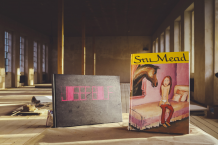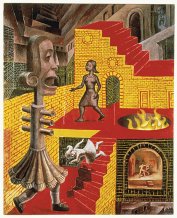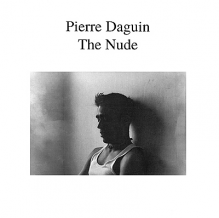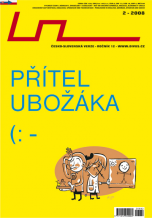| Revista Umělec 2002/4 >> Relational aesthetics (part 2) | Lista de todas las ediciones | ||||||||||||
|
|||||||||||||
Relational aesthetics (part 2)Revista Umělec 2002/401.04.2002 Nicolas Bourriaud | Teoría | en cs |
|||||||||||||
|
Relational aesthetics and random materialism
Relational aesthetics is part of a materialistic tradition. Being “materialistic” does not mean sticking to the triteness of facts, nor does it imply that sort of narrow-mindedness that consists in reading works in purely economic terms. The philosophical tradition that underpins this relational aesthetics was defined in a noteworthy way by Louis Althusser, in one of his last writings, as a “materialism of encounter,” or random materialism. This particular materialism takes as its point of departure the world contingency, which has no pre existing origin or sense, nor Reason, which might allot it a purpose. So the essence of humankind is purely trans-individual, made up of bonds that link individuals together in social forms which are invariably historical (Marx: the human essence is the set of social relations). There is no such thing as any possible “end of history” or “end of art,” because the game is being forever re-enacted, in relation to its function, in other words, in relation to the players and the system which they construct and criticise. Hubert Damisch saw in the “end of art” theories the outcome of an irksome muddle between the “end of the Game” and the “end of play.” A new game is announced as soon as the social setting radically changes, without the meaning of the game itself being challenged.5 This inter human game which forms our object (Duchamp: “Art is a game between all people of all periods.”) nevertheless goes beyond the context of what is railed “art” by commodity. So the “constructed situations” advocated by the Situationist International belong in their own right to this “game,” in spite of Guy Debord who, in the final analysis, denied them any artistic character. For in them, quite to the contrary, he saw “art being exceeded” by a revolution in day- to-day life. Relational aesthetics does not represent a theory of art, this would imply the statement of an origin and a destination, but a theory of form. What do we mean by form? A coherent unit, a structure (independent entity of inner dependencies) which shows the typical features of a world. The artwork does not have an exclusive hold on it, it is merely a subset in the overall series of existing forms. In the materialistic philosophical tradition ushered in by Epicures and Lucretius, atoms fall in parallel formations into the void, following a slightly diagonal course. If one of these atoms swerves off course, it “causes an encounter with the next atom and from encounter to encounter a pile-up, and the birth of the world…” This is how forms come into being, from the “deviation” and random encounter between two hitherto parallel elements. In order to create a world, this encounter must be a lasting one: the elements forming it must he joined together in a form, in other words, there must have been “a setting of elements on one another (the way ice ‘sets’).” “Form can be defined as a lasting encounter.” Lasting encounters, lines and colours inscribed on the surface of a Delacroix painting, the scrap objects that litter Schwitters’ “Merz pictures,” Chris Burden’s performances: over and above the quality of the page layout or the spatial layout, they turn out to be lasting from the moment when their components form a whole whose sense “holds good” at the moment of their birth, stirring up new “possibilities of life.” All works, down to the most critical and challenging of projects, passes through this viable world state, because they get elements held apart to meet: for example, death and tile media in Andy Warhol. Deleuze and Guattari were not saying anything different when they defined the work of art as a “block of affects and percepts.” Art keeps together moments of subjectivity associated with singular experiences, be it Cézanne’s apples or Buren’s striped structures. The composition of this bonding agent, whereby encountering atoms manage to form a word, is, needless to say, dependent on the historical context. What today’s informed public understands by “keeping together” is not the same thing that this public imagined back in the 19th century. Today, the “glue” is less obvious, as our visual experience has become more complex, enriched by a century of photographic images, then cinematography (introduction of the sequence shot as a new dynamic unity), enabling us to recognise as a “world” a collection of disparate element (installation, for instance) that no unifying matter, no bronze, links. Other technologies may allow the human spirit to recognise other types of “world-forms” still unknown: for example, computer science put forward the notion of program, that inflect the approach of some artist’s way of working. An artist’s artwork thus acquires the status of an ensemble of units to be re-activated by the beholder-manipulator. I want to insist on the instability and the diversity of the concept of “form,” notion whose outspread can be witnessed in injunction by the founder of sociology, Emile Durckheim, considering the “social fact” as a “thing”… As the artistic “thing” sometime offers itself as a “fact” or an ensemble of facts that happens in the time or space, and whose unity (making it a form, a world) can not be questioned. The setting is widening; after the isolated object, it now can embrace the whole scene: the form of Gordon Matta-Clark or Dan Graham’s work can not be reduced to the “things” those two artist “produce”; it is not the simple secondary effects of a composition, as the formalistic aesthetic would like to advance, but the principle acting as a trajectory evolving through signs, objects, forms, gestures… The contemporary artwork’s form is spreading out from its material form: it is a linking element, a principle of dynamic agglutination. An artwork is a dot on a line. Form and others’ gaze If, as Serge Daney writes, “all form is a face looking at us,” what does a form become when it is plunged into the dimension of dialogue? What is a form that is essentially relational? It seems worth while to discuss this question by taking Daney’s formula as a point of reference, precisely because of its ambivalence: as forms are looking at us, how are we to look at them? Form is most often defined as an outline contrasting with a content. But modernist aesthetics talks about “formal beauty” by referring to a sort of (con)fusion between style and content, and an inventive compatibility of the former with the latter. We judge a work through its plastic or visual form. The most common criticism to do with new artistic practices consists, moreover, in denying them any “formal effectiveness,” or in singling out their shortcomings in the “formal resolution.” In observing contemporary artistic practices, we ought to talk of “formations” rather than “forms.” Unlike an object that is closed in on itself by the intervention of a style and a signature, present-day art shows that form only exists in the encounter and in the dynamic relationship enjoyed by an artistic proposition with other formations, artistic or otherwise. There are no forms in nature, in the wild state, as it is our gaze that creates these, by cutting them out in the depth of the visible. Forms are developed, one from another. What was yesterday regarded as formless or “informal” is no longer these things today. When the aesthetic discussion evolves, the status of form evolves along with it, and through it. In the novels of polish writer Witold Gombrowicz, we see how each individual generates his own form through his behaviour, his way of coming across, and the way he addresses others. This form comes about in the borderline area where the individual struggles with the Other, so as to subject him to what he deems to be his “being.” So, for Gombrowicz, our “form” is merely a relational property, linking us with those who reify us by the way they see us, to borrow a Sartrian terminology. When the individual thinks be is casting an objective eye upon himself, he is, in the final analysis, contemplating nothing other than the result of perpetual transactions with the subjectivity of others. The artistic form, for some, side-steps this inevitability, for it is publicised by a work. Our persuasion, conversely, is that form only assumes its texture (and only acquires a real existence) when it introduces human interactions. The form of an artwork issues from a negotiation with the intelligible which is bequeathed to us. Through it, the artist embarks upon a dialogue. The artistic practice thus resides in the invention of relations between consciousness. Each particular artwork is a proposal to live in a shared world, and the work of every artist is a bundle of relations with the world, giving rise to other relations, and so on and so forth, ad infinitum. Here we are at the opposite end of this authoritarian version of art which we discover in the essays of Thierry de Duves, for whom any work is nothing other than a “sum of judgements,” both historical and aesthetic, stated by the artist in the act of its production. To paint is to become part of history through plastic and visual choices. We are in the presence of a prosecutor’s aesthetics, here, for which the artist confronts the history of art in the autarky of his own persuasions. It is an aesthetics that reduces artistic practice to the level of a pettifogging historical criticism. Practical “judgement,” thus aimed, is peremptory and final in each instance, hence the negation of dialogue, which, alone, grants form a productive status: the status of an “encounter.” As part of a “relationist” theory of art, inter-subjectivity does not only represent the social setting for the reception of art, which is its “environment,” its “field” (Bourdieu), but also becomes the quintessence of artistic practice. As Daney suggested, form becomes “face” through the effect of this invention of relations. This formula, needless to add, calls to mind the one acting as the pedestal for Emmanuel Lévinas’ thinking, for whom the face represents the sign of the ethical taboo. The face, Lévinas asserts, is “what orders me to serve another,” “what forbids me to kill.”7 Any “inter-subjective relation” proceeds by way of the form of the face, which symbolises the responsibility we have towards others: “the bond with others is only made as responsibility,” he writes, but don’t ethics have a horizon other than this humanism which reduces inter-subjectivity to a kind of inter servility? Is the image, which, for Daney, is a metaphor of the face, only therefore suitable for producing taboos and proscriptions, through the burden of “responsibility”? When Daney explains that “all form is a face looking at us,” he does not merely mean that we are responsible for this. To be persuaded of as much, suffice it to revert to the profound significance of the image for Daney. For him, the image is not “immoral” when it puts us “in the place where we were not,”8 when it “takes the place of another.” What is involved here, for Daney, is not solely a reference to the aesthetics of Bazin and Rossellini, claiming the “ontological realism” of the cinematographic art, which even if it does lie at the origin of Daney’s thought, does not sum it up. He maintains that form, in an image, is nothing other than the representation of desire. Producing a form is to invent possible encounters; receiving a form is to create the conditions for an exchange, the way you return a service in a game of tennis. If we nudge Daney’s reasoning a bit further, form is the representative of desire in the image. It is the horizon based on which the image may have a meaning, by pointing to a desired world, which the beholder thus becomes capable of discussing, and based on which his own desire can rebound. This exchange can be summed up by a binomial: someone shows something to someone who returns it as he sees fit. The work tries to catch my gaze, the way the new-born child “asks for” its mother’s gaze. In La Vie commune, Tzvetan Todorov has shown how the essence of sociability is the need for acknowledgement, much more than competition and violence.9 When an artist shows us something, he uses a transitive ethic which places his work between the “look-at-me” and the “look-at-that.” Daney’s most recent writings lament the end of this “Show/See” pairing, which represented the essence of a democracy of the image in favour of another pairing, this one TV-related and authoritarian, “Promote/receive,” marking the advent of the “Visual.” In Daney’s thinking, “all form is a face looking at me,” because it is summoning me to dialogue with it. Form is a dynamic that is included both, or turn by turn, in time and space. Form can only come about from a meeting between two levels of reality. For homogeneity does not produce images: it produces the visual, otherwise put, “looped information.”
01.04.2002
Artículos recomendados
|
|||||||||||||
|
04.02.2020 10:17
Letošní 50. ročník Art Basel přilákal celkem 93 000 návštěvníků a sběratelů z 80 zemí světa. 290 prémiových galerií představilo umělecká díla od počátku 20. století až po současnost. Hlavní sektor přehlídky, tradičně v prvním patře výstavního prostoru, představil 232 předních galerií z celého světa nabízející umění nejvyšší kvality. Veletrh ukázal vzestupný trend prodeje prostřednictvím galerií jak soukromým sbírkám, tak i institucím. Kromě hlavního veletrhu stály za návštěvu i ty přidružené: Volta, Liste a Photo Basel, k tomu doprovodné programy a výstavy v místních institucích, které kvalitou daleko přesahují hranice města tj. Kunsthalle Basel, Kunstmuseum, Tinguely muzeum nebo Fondation Beyeler.
|






























 New book by I.M.Jirous in English at our online bookshop.
New book by I.M.Jirous in English at our online bookshop.
Comentarios
Agregar nuevo comentario